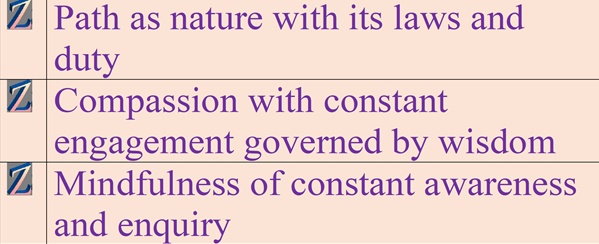2) Pathtivism
Pathtivism is concerned with the path and activism, that activism arises out of following the path, and that there is no necessity for defining activism other than through the path. In other words following the path is all that is needed.
This means there is no need for creeds, dogmas, or isms (except for pathtivism  ) – no ditthupadana (clinging to ideals or idealisms). This is a complete change in the dynamic of activism, and this will be examined later in the chapter. ) – no ditthupadana (clinging to ideals or idealisms). This is a complete change in the dynamic of activism, and this will be examined later in the chapter.
But first we must begin with the path, a word that is bandied around with limited understanding except for those people on the path. And of course anyone can say they are on the path. So let’s try to come to some understanding. At the beginning of MwB Buddhadasa said this:-

[p28 of 161 MwB].
Basically the path is this secret of nature. What are the implications of this? Fundamentally it is that the path is what nature intended for us. Following the path is nature’s intentions, and there comes with this an essential trust in the path. That trust is that if we do what nature intended than it will all be OK. Pathtivism completely trusts nature, sees ourselves as part of nature, and recognises that following the path is our duty in nature.
And this brings me to the next thing Buddhadasa talks about Dhamma-jati:-

[p29 of 161 MwB]
These are the essence of what Buddhadasa talks of as “why we practice Dhamma” – Dhamma-jati and the secret. For pathtivism this is simply following the path. Nature gives us our path – we are born with it, and it is our duty to follow that path; we have no choice it is the law of nature. But there are benefits.
It is worth talking of these benefits, they are exhilarating. People on the path talk of ecstasy or bliss, and the sceptical ask where these come from. They are inherent in the nature of the path. They are even a measure of the path, if there are not the benefits you are not on the path. You can measure yourself, and you can use these measurements as a way of testing your direction. If you drift from the path you drift form the benefits; this is natural law.
See life in terms of the path - Buddhadasa’s Dhamma.
In this companion to pathtivism we will be seeing life in terms of the path – nature and its laws – through the practice of meditation. As we develop meditation we put nature and its laws into practice through following our own paths as is our duty. We become authentic.
As meditation develops our minds (bhavana), we will develop the 4 Dhamma comrades of sati (mindfulness), panna (wisdom), sampajanna (wisdom-in-action) and Samadhi (concentration)[ch4], all essential in following the path. But as pathtivists we first recognise that as we start to follow the path immediately compassion arises. And it is this compassion that governs our activism. Every action is compassion, every decision is compassion, if there is no compassion don’t do it. Every action on the path is compassionate, and if an action is not compassionate then we are not following the path. Duty to nature can be part of our compassion, but duty to an ideal takes us away from compassion and so we have to be mindful of this. I can recall times when political idealism required a duty of me that I could not reconcile. If we think of failed revolutions – can you name a revolution that is still successful?, changing the ruling class to that of the people is a compassionate aim but what has always happened in practice? Suffering. In the Treatise I described the path as:-

A revolution creates suffering, noble aims can create suffering, ideals can create suffering, if this happens it is not the path. For revolutionaries suffering is acceptable, for pathtivists it is not. To be fair to Marx revolution was only meant when the people were ready. In Tsarist Russia they were not, the revolution was primed by the Bolsheviks, and there was suffering. In the Nicaragua of the Sandinista revolution the people were ready, but the global power of the US was destructive – the people of the US were not ready. These actions were not compassionate – the path.
Why did these actions happen? Because the revolutionaries recognised that the prevailing system was creating suffering, and they intended that the revolution would lessen suffering. Sadly the prevailing system was too strong so the revolution could not lessen suffering. This is a lesson of history the compassionate must understand, idealism does not lessen suffering.
But the prevailing system of the 1%-satrapy continues to create suffering so it becomes part of the path to try to end suffering – ending suffering is compassion. How can we end the 1%-satrapy without causing suffering? A very difficult question for the activist.
But more pressing, although clearly connected, for the activist is the destruction of Mother Earth. If we continue to allow our lives to be dominated by the consumerism of the 1%-satrapy, we will start to suffer as life on this planet becomes more and more untenable. We need sustainability which is the exact antithesis of the consumerism of the 1%-satrapy. Compassion for nature is the activist’s primary duty now – the primary pathtivist’s duty.
This compassion requires active engagement but wise engagement, engagement based on wisdom not based on emotion or some set of ideals. Compassion is not a set of rules defined by a written word, it is the application of wisdom to a particular situation and acting on it – sampajanna. A pathtivist might work within a political party if compassion dictates, but a pathtivist is not restricted by the rules and ideals of such. For the compassionate allegiance to an organisation requires constant enquiry.
This brings me to an obvious question. To explain the path I have Dhamma-jati as described by Buddhadasa, the method of Zandtaomed stems from MwB, so why have pathtivism? Why not just Buddhism? This question becomes even more pertinent when I say that much of my learning has come from the Buddha, Buddhadasa and Buddhist teachers. I accept all that the Buddha taught inasmuch as I understand it, there is much I don’t know. I repeat this sentence:- for the compassionate allegiance to an organisation requires constant enquiry. This applies equally to institutions, any allegiance to an institution such as a Buddhist institution requires constant compassionate enquiry. What has to be understood is that once a group of people organise as an institution then that institution gives birth to an “ego”. Because of that ego there are conformities, there are requirements for survival – in this society that means money, and that means potential for control by money – and possibly therefore even control by the 1%-satrapy if they choose. Much of the pathtivist trilogy – Treatise, Manual and Companion – contains Buddhist teachings, Zandtaomed’s meditation is developed from Buddhadasa’s anapanasati-bhavana, but the path cannot be compromised by institutional practices. A pathtivist might choose to become a Buddhist monk, might choose another institutional path, might choose to join a political organisation, but underlying all these decisions must be the wisdom that comes from the path and the compassion that also arises. The pathtivist cannot compromise the path and its duty.
Finally a pathtivist must be questioned for arrogance – ego, it is arrogant not to accept an institutional path with long-established wisdom. Firstly it is part of the ongoing duty of the pathtivist to be mindful of ego. With regards to Buddhist teachings do we accept them because they are Buddhist? And the answer for that lies in the Buddha’s teachings themselves as written in the Kalama sutta – here Buddhadasa talks of the Kalama sutta. My interpretation of this is constant enquiry, not acceptance of any teachings but constant enquiry about the teachings. If the pathtivist has constant enquiry then hopefully there will be no attachment – no ego.
So at this stage I have flagged the understanding of path as nature with its laws and duty. Arising out of the path comes compassion that requires constant active engagement governed by insight and wisdom. And the mindfulness of constant awareness and enquiry to ensure that the mind develops liberation from attachment. This is the pathtivist, and I ask the pathtivist to be aware of this companion thinking throughout their Zandtaomed learning.

Next Ch3 Complete Engagement/Companion Contents/Previous Ch1 Companion Intro
|





